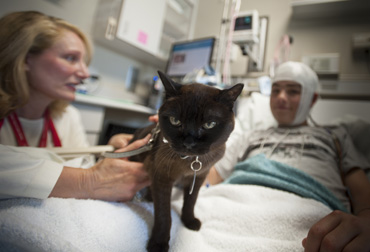
The first thing that comes to mind when thinking about a hospital setting usually is not animals roaming the halls, but specially trained animals and their handlers do just that by bringing emotional and animal assisted therapy to the patients.
A child struggling to read, someone learning basic life skills again after a traumatic injury or illness, an assisted-living senior isolated and alone are just some of the people helped by therapy animals. The purpose of therapy dogs is to emotionally or therapeutically enhance the lives of the people they encounter.
There are two local organizations that evaluate and train animals for assisted therapy. They are Intermountain Therapy Animals and Therapy Animals of Utah. While the Intermountain group is larger and has more funding, they both offer evaluations for the training and mentoring of potential pets. They also take requests from organizations for their services and match handlers and pets to the ideal setting.
Therapy animals are not limited to dogs. A variety of animals such as miniature horses, birds, cats, guinea pigs and even domestic rats are used. Exotic animals including snakes, lizards, and ferrets are not considered for the programs. “There is not enough information about the behavior of the more exotic animals and so they are more unpredictable,” said Gaelyn Derr, executive director of Therapy Animals of Utah.
For a dog to qualify as a therapy animal, it needs to learn basic obedience. The handler and the animal must have a strong connection so that the dog will listen to the handler in any setting. Both organizations look closely at any animal’s temperament. A dog needs to be calm in unfamiliar situations and enjoy lots of attention from different people. The test for a cat or rabbit according to Melissa Byrd of Intermountain Therapy Animals is to be able to sit on different laps and enjoy it.
Handlers are trained to be an advocate for their pet. Their main job is to watch their animal in a therapy setting and make sure they are not becoming stressed. If the animal is getting uncomfortable it is the handler’s job to removed them from the situation.
What the animals do as therapy animals comes natural to them. They offer stress-free and non-judgemental comfort. Studies have been done on why animal therapy works. According to website PsychCentral, “There is actually a psycho-physiological, emotional and physical (component) to interacting with a therapy animal.” Though research is not extensive, what is out there has shown that in the presence of therapy animals stress inducing hormone levels drop and endorphin hormones increase.
A child struggling to read may be embarrassed to read out loud to another student or teacher, but a furry friend sitting close by is ready and eager to listen without judging. As the child gains confidence with the therapy animal their skills improve and their reading levels go up.
A person struggling to walk after an accident or use their hands again can be very self-conscious about not being able to do simple things. Taking the leash of a dog and taking it for a walk or petting a cat shifts the emphasis away from their limitations and has them thinking about the animal. “Even minor things like petting a dog or cat for arm movement is more interesting than working with a therapist,” Byrd said.
Whether it is emotional support for at-risk teens, or physical therapy for a traumatic brain injury patient, therapy animals are just what the doctor ordered. §





